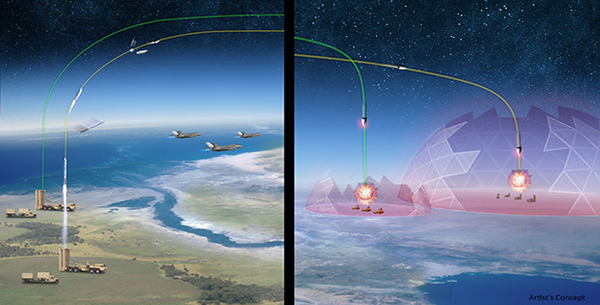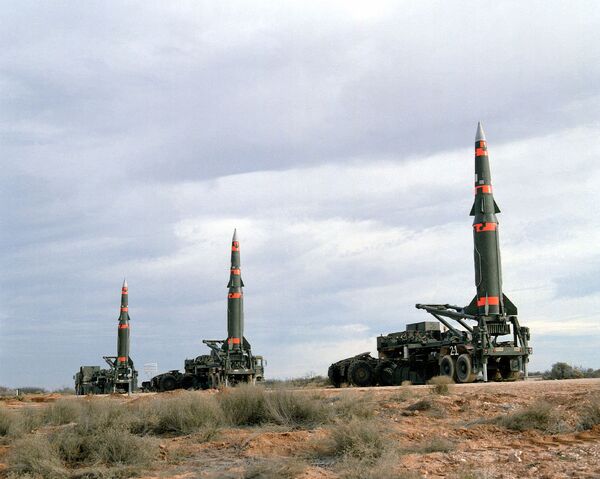The Pentagon’s experimental weapons bureau has announced its program to build a ground-launched intermediate-range hypersonic missile has advanced to the assembly and testing phase.
On Monday, the Defense Advanced Research Projects Agency (DARPA) said the Operational Fires (OpFires) program, being headed up by defense contracting giant Lockheed Martin, would begin the Phase 3b process of development, which includes missile fabrication, assembly and flight testing.
The US has lagged behind Russia and China in hypersonic weapons development for years: both countries already have at least one missile capable of flying faster than 5 times the speed of sound in service, while the US has not yet test-fired any of the hypersonic weapons currently in development.
Earlier this week, Air Force Magazine reported that contrary to expectations by the US Air Force, the AGM-183A Air-launched Rapid-Response Weapon (ARRW) did not get its first test flight last month, reporting the service is now only claiming the test will take place “later this year.” The ARRW is an air-launched hypersonic missile that has so far only performed captive-carry tests under the wing of a B-52 Stratofortress bomber.
The other major US hypersonic weapons program, the Hypersonic Air-breathing Weapon Concept (HAWC) being built by Raytheon, Lockheed Martin and DARPA, has suffered repeated setbacks due to “dumb mistakes,” postponing its test firing until 2021 as well, Air Force Magazine reported.
According to Breaking Defense, DARPA’s program is aimed at the longer-term, with a full test of the weapon not expected before 2023. According to the outlet, the program began in 2017 - before the Trump administration torpedoed the range-limiting INF Treaty - based on the assumption that the treaty banned cruise missiles and ballistic missiles, but not hypersonic missiles.
INF Treaty Range Limits Gone
Signed in 1987, the INF Treaty between the US and the Soviet Union removed from the battlefield ground-based missiles with ranges of between 500 kilometers and 5,500 kilometers (310 to 3,420 miles). The US was the primary loser in this deal, as it required the provocative Pershing II ballistic missiles to be decommissioned. The US had based the nuclear-tipped weapons in Europe several years earlier, boasting they could reach Moscow in just six to eight minutes.
That left a narrow window for a response - and an even narrower margin for error. One incident in 1983 nearly became a nuclear exchange, but the commander of the Soviet radar site that believed it had detected a ballistic missile launch correctly diagnosed the blip as a computer error.
The treaty formally lapsed in August 2019 after the Trump administration claimed Russia had violated the treaty with its Iskander launch system, but Moscow has denied the missiles were in violation of the treaty. Just weeks after the treaty lapsed, the US tested its own treaty-violating missile, a ground-based version of the Tomahawk cruise missile, and had sunk more than $1 billion into new missiles that would have violated the INF Treaty.
More Dangerous Than a Pershing II
However, the OpFires missile promises to be even more dangerous than the Pershing II: according to Breaking Defense, DARPA is trying to make it “throttleable,” enabling it to strike closer targets.
As Breaking Defense explains, solid-fueled rockets are forced to burn through their entire fuel supply once they turn on, and changing the rocket’s trajectory before then can cause the missile to break apart. However, if DARPA can figure out how to make a rocket engine as safe and reliable as a typical solid-fueled rocket, but which can turn its engine off early if necessary like a liquid-fueled rocket, then it can build a super-fast projectile with incredibly versatile range.
“If you give it a lot of energy, it’s going to go far, and it’s actually really hard to make it go less far … without actually breaking it in the process,” DARPA’s program manager, Army Lt. Col. Amber Walker, told Breaking Defense in September.

Last June, Exquadrum carried out its first hot test of just such an engine, on contract from DARPA. However, the other two firms given contracts for the project - Aerojet and Sierra Nevada Corporation - have yet to test their engines. The throttleable engine will be the second stage of the rocket, which activates once it’s already in flight.
Because of the incredible complexity of the weapon’s engine, the rest of the missile will rely on ready-made items, such as the hypersonic glide vehicle the ARRW will use, and a basic solid-fueled first stage rocket engine.
However, Walker told the outlet the Army may not be interested in the OpFires weapon once it’s completed, since it will already have both a ground-launched long-range hypersonic weapon (LRHW) and an intermediate-range conventional missile by then.
The US Air Force has denied it is pursuing a nuclear-tipped hypersonic weapon, but it might have tipped its cards last August when its Nuclear Weapons Center posted a mysterious public solicitation request for, among other things, a potential hypersonic upgrade to an intercontinental ballistic missile. While an ICBM need not be nuclear-armed, all of the US’ ICBMs are.




